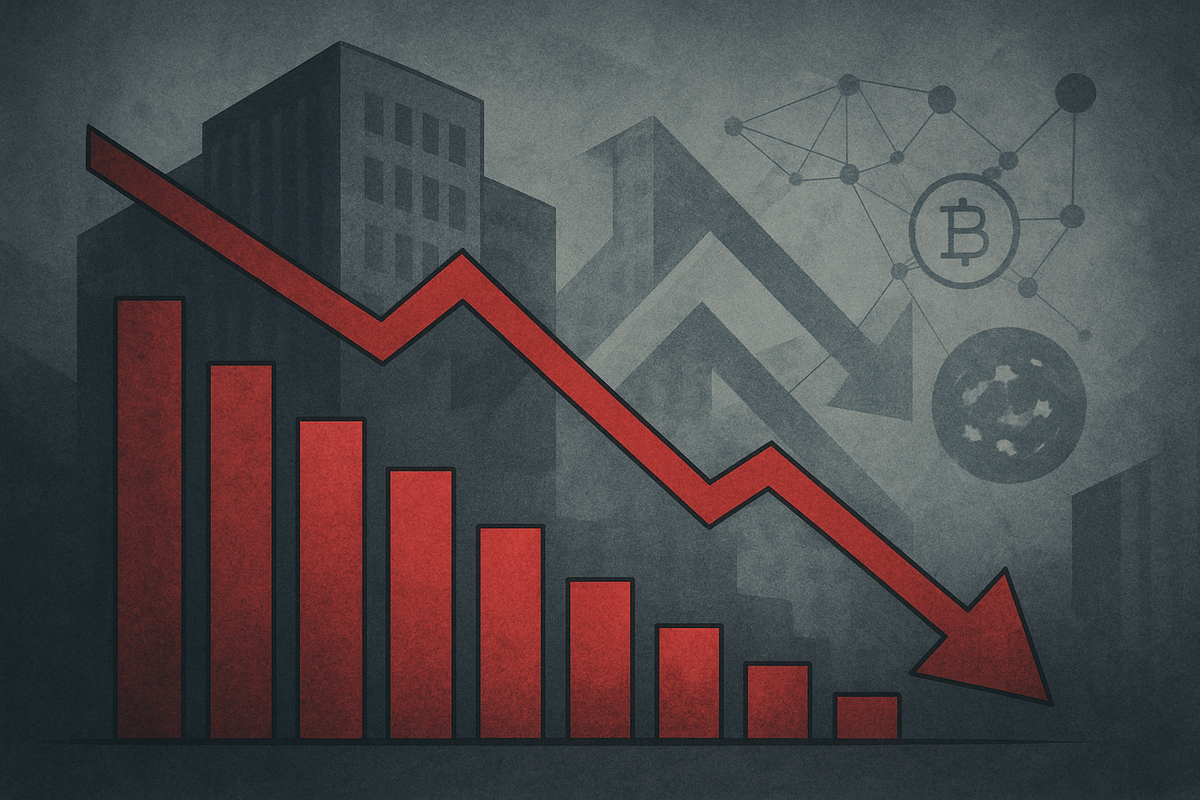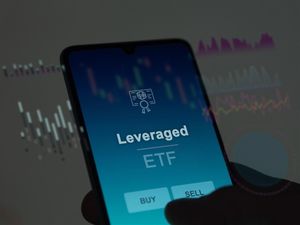
NEW YORK, NY – October 24, 2025 – AiRWA Inc. (NASDAQ: YYAI) saw its stock price plummet by an approximate 51.93% today, closing at a mere $0.0909 per share. This dramatic decline follows the company's announcement of a 1-for-50 reverse stock split, slated to become effective at the market opening on Monday, October 27, 2025. The drastic corporate action has sent shockwaves through the market, signaling deep investor concerns about the company's financial health and its ability to maintain its Nasdaq listing.
The immediate implications of this move are multifaceted. While AiRWA aims to artificially boost its per-share price to comply with Nasdaq's minimum bid price requirement of $1.00, the market's reaction suggests a profound lack of confidence. Such reverse splits are often perceived as a last-ditch effort by struggling companies, frequently leading to further erosion of shareholder value rather than a sustainable recovery. Investors are now grappling with a significantly reduced number of shares and the psychological blow of a company resorting to such measures.
The Mechanics Behind the Meltdown: AiRWA's Strategic Gambit
The 1-for-50 reverse stock split, which became effective at the opening of trading on Monday, October 27, 2025, is a significant corporate action designed to consolidate AiRWA's (NASDAQ: YYAI) outstanding common stock. Specifically, every fifty shares held by an investor have been automatically combined into one new share. This move dramatically reduces the total number of outstanding common shares from approximately 949 million to a more manageable 19 million. While the company's common stock will continue to trade under its familiar Nasdaq ticker symbol "YYAI," it has been assigned a new CUSIP number, 831445507, to reflect the change. Notably, AiRWA has opted to round up any fractional shares, ensuring stockholders receive a whole share rather than cash in lieu. The number of authorized shares and the par value per share remain unchanged, indicating a structural rather than a fundamental alteration of the company's capital.
The path to this reverse split began on July 3, 2025, when AiRWA's (NASDAQ: YYAI) stockholders and Board of Directors approved a proposal authorizing the CEO to implement a reverse stock split within a broad range of 1-for-5 to 1-for-50. This provided the leadership with flexibility in determining the precise ratio. It wasn't until October 23, 2025, that the company publicly announced its decision to proceed with the maximum ratio of 1-for-50, simultaneously filing a current report on Form 8-K with the Securities and Exchange Commission to detail the specifics. The swift implementation saw the split-adjusted shares commence trading just four days later. Key stakeholders in this process included the AiRWA Board and its stockholders, who granted the initial authorization, and the Chief Executive Officer, who ultimately selected the 1-for-50 ratio. Nasdaq (NASDAQ), as the governing exchange, played a crucial role by setting the minimum bid price requirement that catalyzed this action, while ClearTrust, LLC served as the appointed exchange agent, facilitating the administrative aspects of the split.
AiRWA's (NASDAQ: YYAI) stated objectives for the reverse stock split are twofold: primarily, to regain compliance with Nasdaq's (NASDAQ) $1.00 minimum bid price rule, thereby staving off potential delisting. Secondly, the company aims to enhance its appeal to institutional investors, many of whom are restricted from investing in "penny stocks" or those trading below a certain price threshold. However, the market's reaction extends beyond the immediate price drop, signaling deeper concerns. Industry observers view such aggressive reverse splits as a strong indicator of financial distress, questioning the company's underlying health. AiRWA's recent financial performance paints a challenging picture, with a staggering 93.2% decline in revenue growth over the past three years and persistent profitability issues reflected in a -9.18% net margin. An Altman Z-Score of 1.52 places the company firmly in the "distress zone," raising bankruptcy risks, while a Beneish M-Score of 70.48 suggests potential financial manipulation. These metrics, coupled with low institutional ownership (2.03%) versus high insider ownership (76.97%), underscore a precarious financial position despite the company's ventures into Web3 and real-world asset (RWA) tokenization through its AiRWA Exchange. The historical context also reveals a complex corporate identity, with previous reverse splits for the YYAI ticker attributed to "Connexa Sports Technologies Inc.," suggesting a significant rebrand or strategic pivot to its current focus.
Winners and Losers in AiRWA's Reverse Split Aftermath
The aftermath of AiRWA Inc.'s (NASDAQ: YYAI) 1-for-50 reverse stock split creates a clear delineation between potential winners and losers, primarily stemming from the company's precarious financial position and its ambitious, yet volatile, strategic pivot. For AiRWA itself, the immediate "win" is the procedural compliance with Nasdaq's (NASDAQ) minimum $1 bid price requirement, which temporarily fends off delisting. This administrative success, however, is overshadowed by a substantial loss of investor confidence and a significant erosion of its market capitalization, which now hovers between $1.36 million and $2.75 million. The market's overwhelmingly negative reaction underscores the perception of a company in distress, using a cosmetic fix rather than demonstrating fundamental strength. Despite decent liquidity metrics—a current ratio of 3.54 and a low debt-to-equity ratio of 0.03 to 0.1—AiRWA's operational performance tells a grimmer story, marked by a shocking 93.2% decline in revenue growth over the past three years and a persistent negative net margin of -9.18%. Its Altman Z-Score of 1.52 places it squarely in the "distress zone," raising bankruptcy risks, while negative operating cash flow indicates a struggle to cover its debts from core operations.
Existing shareholders of AiRWA (NASDAQ: YYAI) are among the most immediate losers. While a reverse split is theoretically value-neutral at the moment of execution—fewer shares at a proportionally higher price—the subsequent market plunge means investors have already suffered significant losses in the total market value of their holdings. This negative market perception often begets continued selling pressure, potentially leading to further stock price depreciation. Furthermore, the dramatic reduction in outstanding shares, from approximately 949 million to just 19 million, could lead to decreased stock liquidity, making it more challenging for shareholders to execute trades and potentially widening bid-ask spreads. The company's decision to round up fractional shares is a small concession for small shareholders, but it does little to offset the broader financial anxieties. The stark contrast between high insider ownership (ranging from 76.97% to 89.51%) and extremely low institutional ownership (2.03%) further highlights a lack of broader market confidence, suggesting that sophisticated investors are largely avoiding the stock.
The ripple effects extend to AiRWA's (NASDAQ: YYAI) partners and competitors within the burgeoning Web3 and Real-World Asset (RWA) tokenization space. JuCoin Capital, a 49% joint venture partner in the AiRWA Exchange, stands as a significant potential loser. With a commitment of $250 million to the RWA tokenization platform, JuCoin's substantial investment and its reputation within the Web3 ecosystem are now directly exposed to AiRWA's financial instability and negative market sentiment. The planned initial rollout to 4 million users from JuCoin's ecosystem also faces considerable risks if the platform's perceived stability is compromised. Indirectly, the Solana (SOL) ecosystem, with which AiRWA has aligned through a $30 million token investment and platform integration, could experience a marginal dampening of enthusiasm for Solana-based RWA tokenization if the AiRWA Exchange fails to deliver. Conversely, established competitors in the RWA tokenization sector, such as Securitize, Polymath, Swarm Markets, Smartlands, Centrifuge, Ondo Finance, and tZERO, could emerge as winners. AiRWA's current turmoil might deter investors and users, prompting them to seek out more stable, reputable, and financially sound platforms, thereby diverting capital and interest to these competitors. Ultimately, the broader RWA tokenization market, projected to be worth trillions, is likely resilient enough to absorb one struggling player, viewing AiRWA's situation as an isolated case rather than an indictment of the entire sector's potential.
Wider Significance: A Bellwether for High-Risk Pivots in Nascent Markets
AiRWA Inc.'s (NASDAQ: YYAI) dramatic stock decline and its defensive 1-for-50 reverse stock split serve as a potent bellwether for the broader challenges and inherent risks within the nascent Web3 and Real-World Asset (RWA) tokenization industries. While the reverse split is an immediate tactical move to comply with Nasdaq's (NASDAQ) $1.00 minimum bid price, it is fundamentally a symptom of deeper operational and financial distress, evidenced by a staggering 93.2% revenue decline over the past three years and a persistent negative net margin of -9.18%. This situation highlights that even companies attempting to tap into potentially lucrative future markets can falter if their underlying fundamentals are weak and execution is flawed.
AiRWA's (NASDAQ: YYAI) strategic pivot into RWA tokenization, particularly its focus on tokenized U.S. stocks via the AiRWA Exchange, aligns with a significant industry trend that seeks to bridge traditional finance with blockchain technology. Analysts project the RWA market to grow into the trillions, signifying a massive opportunity. However, AiRWA's struggles also reflect several critical challenges endemic to this high-risk sector. The Web3 space, much like early internet ventures, is often characterized by speculative fervor rather than sustained value creation, leading to extreme stock volatility, as seen in AiRWA's 52-week trading range of $0.0670 to $6.33. Beyond speculation, technological complexities such as smart contract vulnerabilities and cybersecurity risks pose substantial hurdles. Furthermore, regulatory ambiguity remains a significant impediment, with a lack of clear frameworks for classifying tokens, ensuring compliance with anti-money laundering (AML) and know-your-customer (KYC) regulations, which deters institutional adoption. The reliance on structures like Special Purpose Vehicles (SPVs) and Alternative Investment Funds (AIFs) for some RWA companies also raises questions about whether tokenization genuinely adds substantial value beyond traditional financial structures.
The ripple effects of AiRWA's (NASDAQ: YYAI) predicament could be felt by both its partners and competitors. JuCoin Capital, a 49% joint venture partner in the aiRWA crypto exchange, faces considerable financial and reputational risk, with its $250 million investment and the very launch of the exchange potentially jeopardized. The broader Solana (SOL) ecosystem, with which AiRWA has aligned through a $30 million token investment and platform integration, could also experience a marginal, albeit temporary, dampening of enthusiasm for RWA tokenization if the AiRWA Exchange struggles. Conversely, this event could act as a catalyst for a "flight to quality" within the RWA tokenization market. More established and financially robust competitors like Securitize, Polymath, Swarm Markets, Smartlands, Centrifuge, Ondo Finance, and tZERO could benefit by attracting investors and users who are now wary of less stable platforms. However, a high-profile failure could also increase regulatory scrutiny across the entire sector, potentially making it harder for all RWA projects to raise capital or gain user trust.
From a regulatory standpoint, AiRWA's (NASDAQ: YYAI) challenges will likely intensify calls for clearer guidelines in the RWA space, focusing on transparency, investor protection, and the legal enforceability of tokenized ownership. Jurisdictions like Hong Kong, with its "See-Through Approach" to RWA regulation, which focuses on the underlying asset's financial attributes rather than just the token form, could serve as models for future frameworks. Historically, companies making high-risk strategic pivots into emerging technologies have often faced similar fates. The dot-com bubble of the late 1990s and early 2000s saw numerous companies with speculative valuations fail when they couldn't sustain growth or monetize their new internet-based strategies. Similarly, reverse stock splits themselves have a poor track record, often being a last resort for companies trying to avoid delisting, with many continuing to decline due to unaddressed underlying financial problems. AiRWA's situation thus serves as a cautionary tale, highlighting the formidable challenges of execution, market acceptance, and profitability in a complex and evolving industry that demands robust fundamentals beyond mere technological aspiration.
What Comes Next: Navigating the Choppy Waters of Web3 and Corporate Survival
For AiRWA Inc. (NASDAQ: YYAI), the immediate future is fraught with challenges, yet it also presents a make-or-break opportunity to validate its ambitious pivot into the Web3 and Real-World Asset (RWA) tokenization space. In the short term, the company is likely to experience continued stock volatility as the market digests the effects of the 1-for-50 reverse stock split, which became effective on October 27, 2025. The critical imperative for AiRWA is to successfully maintain compliance with Nasdaq's (NASDAQ) minimum bid price, thereby avoiding the specter of delisting. However, the ultimate success of this period will hinge squarely on the effective launch and initial user adoption of the AiRWA Exchange, particularly its focus on tokenized U.S. stocks. Rebuilding investor confidence, shattered by significant stock declines and a prolonged period of revenue contraction, will demand clear communication of milestones and a demonstrated, credible path to profitability within its new Web3 venture.
Looking further ahead, AiRWA (NASDAQ: YYAI) harbors the long-term possibility of establishing itself as a key player, or even a leader, in the tokenization of U.S. stocks, provided its AiRWA Exchange gains substantial traction, liquidity, and a reputation for regulatory compliance. While its legacy technology solutions in "localized digital matchmaking" might offer unforeseen synergies, the primary growth vector will undoubtedly be its RWA offerings. Successful execution could pave the way for expansion into other lucrative RWA categories such as real estate, private credit, or commodities, aligning with broader market trends and attracting further institutional partnerships. However, this trajectory demands critical strategic adaptations. AiRWA must articulate a compelling and differentiated value proposition for its exchange, especially against a backdrop of established competitors. Addressing its chronic financial health issues—specifically reversing the -93.2% revenue decline and achieving sustainable profitability—is paramount. Proactive engagement with regulators, ensuring stringent compliance (as indicated by its partnership with Inca Digital), continuous innovation in blockchain infrastructure, robust security measures, and a seamless user experience will be non-negotiable for long-term survival and growth. Effective capital management and the ability to secure additional funding will also be crucial to fuel its development.
The broader Web3 and RWA tokenization market, meanwhile, stands at a pivotal juncture, poised for potentially explosive growth while grappling with significant hurdles. Opportunities abound, with projections for the RWA market reaching anywhere from $10 trillion by 2030 to $30 trillion by 2034. This growth is driven by the promise of enhanced liquidity, increased accessibility through fractional ownership, 24/7 trading, and growing institutional adoption from financial giants like BlackRock (NYSE: BLK), JPMorgan (NYSE: JPM), and Goldman Sachs (NYSE: GS). The diversity of tokenizable assets—from real estate and government bonds to private credit and carbon credits—underscores the vast potential for efficiency and transparency through blockchain's immutable records and smart contracts. Yet, formidable challenges persist, including persistent regulatory uncertainty across jurisdictions, the technical complexities of integrating blockchain with traditional finance, inherent security risks from coding errors and hacking, and concerns about market liquidity for niche tokenized assets. Valuation and pricing difficulties for heterogeneous, illiquid assets also remain a significant hurdle.
For AiRWA (NASDAQ: YYAI), potential scenarios range from an optimistic transformation where the AiRWA Exchange thrives, generating strong revenues and restoring stock growth, to a pessimistic outcome of stagnation or outright failure due to intense competition, regulatory roadblocks, or an inability to attract liquidity, potentially leading to further depreciation, delisting, or even bankruptcy. For the broader Web3/RWA market, an optimistic scenario envisions mainstream financial integration, rapid expansion, and market capitalization reaching the highest projections. A moderate path suggests phased adoption, steady growth despite ongoing regulatory and integration challenges, with specific asset classes flourishing. Conversely, a pessimistic outlook could see regulatory bottlenecks, persistent security concerns, or major market failures stifling innovation, leading to slower growth or a contraction, relegating RWA tokenization to a niche within the wider crypto ecosystem. AiRWA's journey will undoubtedly offer valuable lessons for the entire industry as it navigates this complex, high-stakes landscape.
Comprehensive Wrap-up: A Cautionary Tale in a Transformative Market
AiRWA Inc.'s (NASDAQ: YYAI) recent 1-for-50 reverse stock split and the ensuing stock market tumble encapsulate a critical moment for a company undergoing a profound transformation. The key takeaway is that while the reverse split, effective October 27, 2025, served its immediate purpose of boosting the per-share price to meet Nasdaq's (NASDAQ) minimum bid requirement, it was perceived by the market as a "procedural lifeline" rather than a sign of fundamental strength. The dramatic 51.93% stock decline on the announcement day, reducing outstanding shares from approximately 949 million to about 19 million, underscores a significant loss of investor confidence, signaling deep concerns about the company's underlying financial health and the viability of its high-risk strategic pivot.
AiRWA's (NASDAQ: YYAI) current situation is one of stark contrasts. The company has boldly rebranded from Connexa Sports Technologies Inc. and staked its future on the Web3 and Real-World Asset (RWA) tokenization space, primarily through its AiRWA Exchange—a $500 million joint venture with JuCoin Capital. This exchange, focusing on tokenized U.S. equities and leveraging the Solana (SOL) blockchain, has reported successful test runs, hinting at its technical capabilities. Yet, beneath this ambitious new facade, the company's financial foundation appears shaky. A staggering -93.2% decline in revenue growth over the past three years and a negative net margin of -9.18% paint a picture of operational distress. While liquidity is solid and leverage low, an Altman Z-Score of 1.52 places AiRWA in a "distress zone," indicating a heightened risk of bankruptcy, further complicated by a Beneish M-Score of 70.48, which suggests potential financial manipulation. The low institutional ownership (2.03%) versus high insider ownership (76.97%) reinforces the speculative nature of the investment.
Moving forward, the market's assessment of AiRWA (NASDAQ: YYAI) will remain highly speculative. The success of its Web3 pivot, specifically the AiRWA Exchange, is paramount. The company must demonstrate its ability to attract users, facilitate substantial trading volumes for tokenized U.S. equities, and, most critically, generate sustainable revenue and profitability. The broader Web3/RWA tokenization market, however, is projected for substantial growth, with conservative estimates placing it at $2-4 trillion by 2030 and some optimistic forecasts reaching $30 trillion. This growth is driven by increasing institutional adoption, evolving regulatory clarity, the expansion into diverse asset classes (from real estate to carbon credits), and continuous technological advancements in blockchain scalability and efficiency. AiRWA is attempting to ride this wave, but its current instability makes it a high-risk proposition.
The lasting impact of AiRWA's (NASDAQ: YYAI) reverse stock split will ultimately be defined not by the share consolidation itself, but by the company's ability to execute its ambitious Web3 strategy successfully. Historically, reverse splits often serve as a temporary reprieve, buying time for companies to address underlying issues, but rarely do they fundamentally alter a struggling business's trajectory without significant operational improvements. For investors, the coming months will be crucial. They should meticulously watch the AiRWA Exchange's performance, looking for concrete signs of user adoption, trading volume, and progress in its tokenized U.S. equities platform. A financial turnaround, marked by positive revenue growth and a clear path to profitability, is essential. Furthermore, monitoring improvements in its Altman Z-Score and Beneish M-Score, along with the execution of its joint venture with JuCoin Capital, will be key indicators of long-term viability. Beyond company-specific metrics, investors should also keep a keen eye on broader Web3/RWA market trends, including regulatory developments, institutional adoption rates, technological advancements, and competitor activities, as these will shape the overall landscape in which AiRWA is attempting to survive and thrive. AiRWA's journey serves as a compelling, albeit cautionary, tale of the immense opportunities and formidable challenges inherent in navigating the transformative but often turbulent waters of emerging financial technologies.
This content is intended for informational purposes only and is not financial advice






